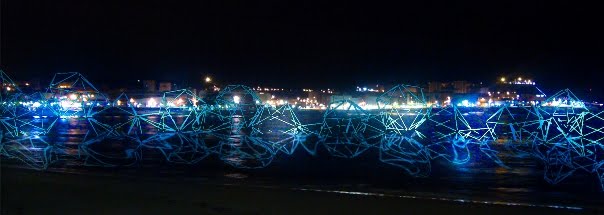Thursday, January 21, 2010
Wednesday, January 20, 2010
Design Intervention + Parameters
The intervention envisages the creation of a longer, subtler striation between the two conditions of the sand bar and the water.
The installation will not interact directly with user but create an enclosure which the user could interact with. This indirect interaction between the user and installation serves the purpose of the installation primarily corresponding to the waves and breaking them and then interacting with the other forces-human conditions, site conditions and variations.
Parameters
Buoyancy – The icosahedrons aggregated together respond to the change in the forces (tides, winds and waves)
Anchorage – One anchor point is in the land and the other end is free to move in the water, responding to the forces
Patterns – The patterns are created by a constant movement of the waves, tides and the winds. The patterns in the dynamics of the components and the form of the installation itself are defined by the forces. The change in patterns is evident with time, the movement of tides and through the seasons.
Movement and stability – The movement is free but controlled with the extents of the joinery. The stationery part of the structure is anchored to the ground on the beach. This may gradually transform over a period of time.
Waves – The idea of the repeated changing forces from the sea creating different surface enclosures. The waves dissipate forces to the icosahedrons which are aggregated together. These components create the enclosure based on their reaction to the forces
Temporality – The dynamic form changes its area, enclosure, appearance, depths based on the waves. The waves change in terms of their forces and the aggregated icosahedrons change the form of the installation.
Occupancy nature – The idea is to make the installation a catalyst for change. The people do not interact with the installation; they interact due to the installation. Therefore the idea of the installation is to further blur the present boundary between the sand and water with its insertion. The human interacts with the space thus created and the installation becomes the hidden force.
Relation to the city – The beach is perceived as a buffer but it also has abrupt endings. The sand bar, instead of being a natural buffer is densely occupied. The idea of the aggregate forming the enclosure is to make the activity on the sand bar move towards the water and hence make the strip striated along its length. The imagining volume of the sand bar is broken down and spread onto the water edge.
City Fringe - Beach
Blurred transitional space - The volume being broken down and further striated
Lack of demarcation, access or termination – The present boundary of sand and water is broken down and this demarcation becomes evident when people inhabit the space. The access becomes free depending on the position of the installation, its scale and the position
Utilization and occupancy – The installation creates a sub-enclosure, a blurred version of a small scaled beach in itself, for people to inhabit. Therefore indirect occupancy and utilization
Confluence of sea/land – striation leads to a two way connect between the two elements and the confluence is further blurred and broken down when and where the installation is placed
Invention of program – A small pool becomes the program. The surrounding precincts can be vital in adding to the conditions in the pool – leisure activities. Extension of the land into the sea creates a new condition to inhabit. The pool forms this more natural, cohesive and interactive setting. It responds to the forces of nature, relates to the sea and sand through an intervention and acts according to the changing force conditions.
Tuesday, January 19, 2010
Site Overview

The beach is perceived to be a buffer between the city and the surrounding coast acting as one of the few leisure spots within the dense cityscape. It is a fringe condition between the land and the sea. The beach is a void within the mass of the urban metropolis of Mumbai which attracts users in huge numbers all year round. This led to an imbalance in the distribution of density between the fringe conditions and the leisure spots. In some cases the increase in the density caused the degradation of some of the beaches. The coast acts as a natural striation but the striation cannot accommodate the existing forces acting on it-the proportion of the users to the area it covers is too large. Hence, the coastal stretch appears to be an invisible, over-used mass, filled with people and human activity which it cannot serve. The apparent overuse of the sandbar and the relatively sparser use of the water’s edge is the main factor governing this problem. Moving the density of people from the sand to the water can bridge this invisible gap and can lead to a more even distribution between the segments of the beach. This shift would make the fringe appear once again on the coast and make the boundary between the land and water wider and deeper.
Subscribe to:
Comments (Atom)


![[High+tide+copy.jpg]](https://blogger.googleusercontent.com/img/b/R29vZ2xl/AVvXsEiycnECnlhBB7ZwINrg2E9KHxwmeMVlml9vVxcbfibH1kWJspyBRwFu0s-XLFnN738S9nSwVYBCj3S_5ucIScApRplb9YlZspA6O2IMyqtNxSrv8zgqptjsqzOOzM4WjR1cbygnNmo1B6in/s400/High+tide+copy.jpg)
























